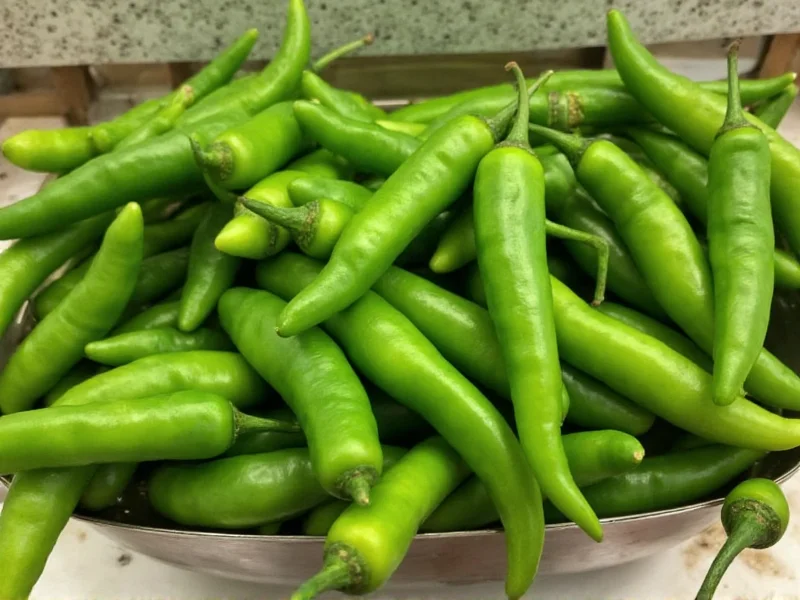Understanding jalapeño heat levels is essential for home cooks, chefs, and spice enthusiasts. The Scoville scale, developed by pharmacist Wilbur Scoville in 1912, measures the concentration of capsaicinoids—the compounds responsible for a pepper's heat. While jalapeños are considered moderately spicy, their actual heat can vary dramatically based on several factors.
What Are Scoville Heat Units?
Scoville Heat Units quantify the pungency of chili peppers and other spicy foods. Originally determined through human taste testing, modern measurements use high-performance liquid chromatography (HPLC) for precise capsaicin concentration analysis. The higher the SHU value, the hotter the pepper. For context, bell peppers register at 0 SHU, while the Carolina Reaper can exceed 2,000,000 SHU.
Jalapeño Heat Range Explained
The standard jalapeño pepper heat range of 2,500-8,000 SHU represents significant variability. Several factors influence where a specific jalapeño falls within this spectrum:
- Stress conditions: Peppers grown with less water or in nutrient-deficient soil often develop higher capsaicin levels
- Maturity: Red jalapeños (fully ripe) are typically hotter than green ones
- Seed placement: The white pith surrounding seeds contains the highest capsaicin concentration
- Cultivar differences: Some jalapeño varieties like 'Mucho Nacho' or 'Jalafuego' are bred for consistent heat
| Pepper Type | Scoville Heat Units (SHU) | Heat Level |
|---|---|---|
| Bell Pepper | 0 | Mild |
| Jalapeño | 2,500-8,000 | Medium |
| Serrano | 10,000-23,000 | Hot |
| Habanero | 100,000-350,000 | Very Hot |
| Ghost Pepper | 855,000-1,041,427 | Extremely Hot |
Practical Implications for Cooking
Knowing the jalapeno scoville rating helps in recipe planning. For milder dishes, remove seeds and white membranes where capsaicin concentrates. If you need consistent heat levels for canning or commercial production, consider using jalapeño varieties specifically bred for uniform spiciness.
Interestingly, the same jalapeño plant can produce peppers with different heat levels throughout the growing season. Environmental stressors like drought actually increase capsaicin production as a defense mechanism. This explains why two jalapeños from the same plant might taste noticeably different in heat intensity.
Common Misconceptions About Jalapeño Heat
Many believe that smaller jalapeños are always hotter, but size isn't a reliable indicator. The presence of 'corking'—those light-colored striations on the pepper's skin—often indicates higher stress during growth and potentially greater heat, though this isn't an absolute rule.
Another misconception is that cooking significantly reduces jalapeño heat. While prolonged cooking can mellow flavors, capsaicin remains stable through most cooking processes. The heat becomes more evenly distributed rather than eliminated.
Selecting Jalapeños Based on Desired Heat
When shopping for jalapeños, look for these indicators:
- For milder heat: Choose smooth, uniformly green peppers with few cork marks
- For medium heat: Select peppers with some light striations (corking)
- For hotter peppers: Look for more pronounced corking and consider red (fully ripe) jalapeños
Remember that individual tolerance to capsaicin varies significantly. What seems mild to one person might be uncomfortably hot to another. Always taste a small piece before adding jalapeños to dishes, especially when cooking for others.
Measuring Jalapeño Heat at Home
While professional Scoville testing requires laboratory equipment, you can conduct a simple comparative test at home. Prepare identical portions of dairy (which neutralizes capsaicin), then taste different jalapeños while timing how long the burn sensation lasts. This relative measurement helps compare peppers from different sources, though it won't give precise SHU values.
Conclusion
Jalapeños' 2,500-8,000 SHU range makes them versatile for various culinary applications. Understanding what affects jalapeño scoville units helps manage heat levels in cooking. Whether you're making salsa, poppers, or adding subtle heat to dishes, recognizing the factors that influence jalapeño spiciness allows for more consistent results. The next time you handle jalapeños, consider their growing conditions and physical characteristics to better predict their heat level.
Frequently Asked Questions
Why do some jalapeños taste hotter than others?
Jalapeño heat varies due to growing conditions, maturity level, and genetics. Stress factors like drought increase capsaicin production, making peppers hotter. Red jalapeños (fully ripe) are typically hotter than green ones, and the white pith surrounding seeds contains the highest concentration of capsaicin.
How can I reduce the heat of jalapeños in cooking?
To reduce jalapeño heat, remove the seeds and white membranes where capsaicin concentrates. Soaking sliced jalapeños in salt water or milk for 15-30 minutes can also draw out some capsaicin. Cooking with dairy products like cheese or sour cream helps counteract the heat when serving.
Are red jalapeños hotter than green jalapeños?
Generally yes. Red jalapeños are fully ripe versions of green jalapeños and typically measure higher on the scoville scale for jalapenos. As jalapeños mature and change color from green to red, they develop more capsaicin, resulting in increased heat. Red jalapeños also have a slightly sweeter flavor profile compared to their green counterparts.
What's the difference between jalapeños and serranos?
Serranos typically range from 10,000-23,000 SHU, making them significantly hotter than jalapeños (2,500-8,000 SHU). Serranos have a brighter, more intense heat with less vegetal flavor than jalapeños. They're smaller, smoother, and grow pointing upward on the plant, while jalapeños are larger with characteristic striations and grow downward.











 浙公网安备
33010002000092号
浙公网安备
33010002000092号 浙B2-20120091-4
浙B2-20120091-4